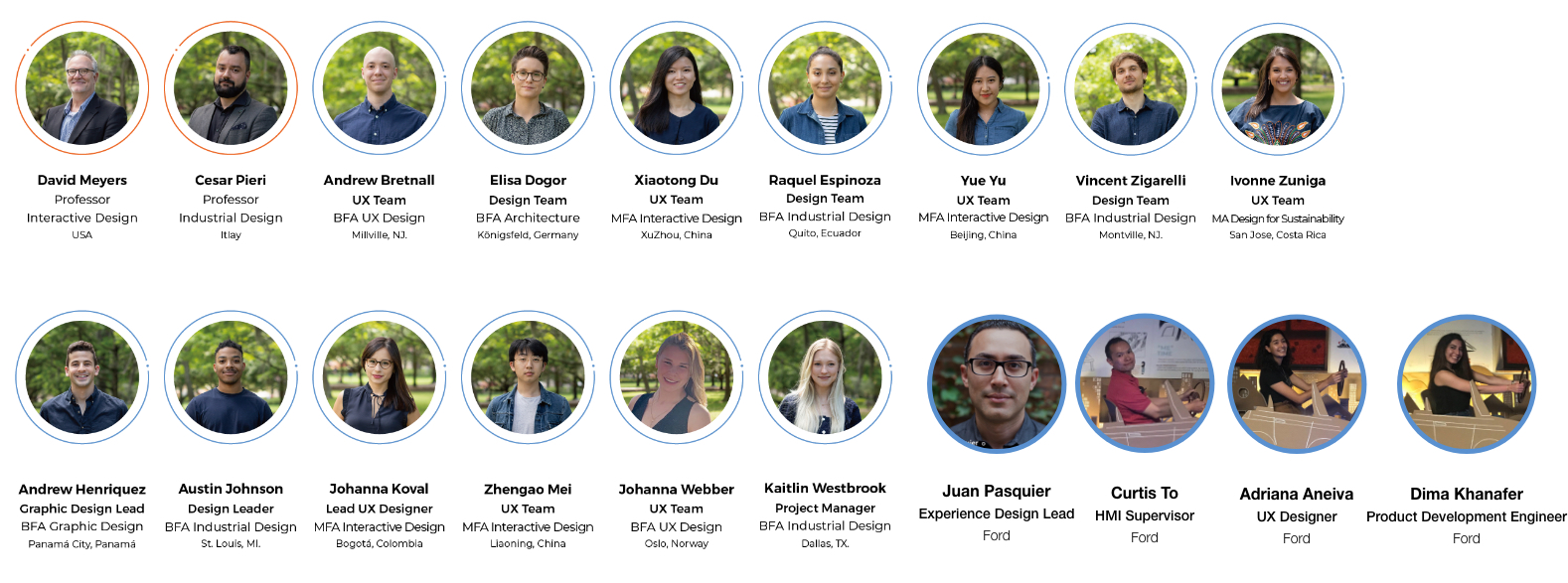ABOUT
FORD YOUNIVERSE is a collaborative project designed by FORD and SCAD. Thirteen students from different majors and countries collaborated with Ford UX team to design the mobility experience in 2022.
| Date: | March-May, 2019 |
| My Role: | UX Researcher, UX Designer, |
Meet The Team
Meet the Ford x SCADpro team: a brilliant mix of skills and character, handpicked by the professors to work together. Collaboration is the root of any great project and every single soul in the group helped make this project what it is.

Our Process


My Reflections
1. Don't fall into the trap of technical constrains

Designing product for the near future requires designers to use the existing technology. The team creates solutions based on current technology. However, we ended up researching more technologies instead of discovering users' real needs. Nowadays, It’s easy to fall into a trap of technology constraints. UX design should be able to stimulate the innovation of technology instead of being restricted by it. That’s the right time to go through the user research and find overarching themes. Ask the team what are the three most important problems or opportunities for us to design. Most of the time you will find that technology is not the key issues. What matters is how technology can solve these problems and meet their needs.
2. Personas OR Archetypes?

As UX designers, we usually create personas to represent our users. We tend to neglect if there is any better option to represent our users. Before deciding which tools are right for your project, it’s essential to understand the definition of each method. Archetypes are constructed based on user research. It expresses the behaviors and attitudes of different types of consumers. Personas are fictional characters that sit beneath Archetypes — a breakdown of the archetypes into distinct personalities. It brings artificial characters to represent users in our daily life. It has a name, age, gender, occupation or motivation and frustration. However, when it comes to a product or a service for a global brand, user personas is not an appropriate tool to represent a wide variety of groups and their behaviors. Also, It can't persuade your internal stakeholders to believe that they are the only target users. Archetypes focus on different behavior patterns and attitudes towards a product or service. In our project, we separated users into three archetypes based on user research. Jolly drivers, who love driving and spending time in their cars. Functionalist drivers, on the other hand, are more focus on the functions and convenience that a car can bring in their lives. They drive cars for work, shopping or travels. Extreme drivers will spend a long time driving every day. They can even be a Uber driver who drives for a living. Thus, Archetypes represents a group of people with different demographics but they still share similar behavior patterns and goals.
3. What can be called as a good How Might We Question?

We spend several weeks to conduct user research and synthesize insights. How might we inspire designers for brainstorming? One way is to write How Might We question. We break single insights into several How Might We questions. However, we never stop there. The Ford team challenge us to think if our How Might We questions are broad to inspire multiple solutions. If the questions only have one solution, then broaden the question. I realized that the way you use tools will directly impact the final solutions. Stanford D school provides an example to write inspirational HMWs from different perspectives. For instance, try to amp up the good, explore the opposite, focus on emotions or even take it to an extreme.
4. Push Ideas Further
One thing I learned most from this design process is to be brave to doubt your first sketch or initial solutions. We have a design team started sketching on the first day of this project. We bring assumptions and subjective to the design concepts. However, we also challenge our concepts by asking questions What’s the next level? What’s next? For example, we designed smart keys for cars. What if there is no key in the future? What the experience looks like? What if the interaction with the car will seamlessly embed into your current product and service in your life. Several rounds of pushing concepts further enable our team to dig deep into the real needs of users, fill out their life gaps and design the real innovative solutions.
5. Tell a good story
It is widely believed that the importance of selling your concepts is as same as the concept itself. The way to sell your ideas can be different. Learning from your clients and ask for their needs, problems constraints, context will help you find the best way to present the final concepts. Our client encourages us to tell a good story. They like our draft concepts and expect we will surprise them by selling them. We challenge ourselves to go beyond traditional keynote presentation. We combine projectors, videos, and physical prompts to create an immersive experience for our clients.
6. Redefine My Role
There are many benefits to divide roles according to various skill sets. It makes collaboration more efficient because we know who to ask for help when we need some professional skills in the team. However, always be prepared to wear different hats in the design process is the best way to collaborate with talented designers. A great teamwork experience is where you can explore what you can do and get the most use of what you are good at.
